#switch I can lie and and just say it’s a portable device I’ve been using it in here that’s why it’s missing
Explore tagged Tumblr posts
Text

Key lock doorknob done 👌
#get out of my house ya bitch#I’ve already got the switch in here and some valuables#honestly I’d love to move the ps4 and stuff but I don’t want to immediately raise flags that I’m prepping for him to be dumb#switch I can lie and and just say it’s a portable device I’ve been using it in here that’s why it’s missing#but the whole ps4 moving would raise red flags#but if it gets smashed or stolen n sold I’ll be fuckin calling cops I promise you that
11 notes
·
View notes
Photo

Laser Comb For Hair Regrowth-Hair Loss Reviews Many of the people with hair loss issues hide the problem under hats and wigs or use other means of treatment creams, shampoos and conditioners to get rid of the problem. While some of the products in the market work, others may leave the situation worse than it was. Others come with claims of regrowing the hair fast, which never happens. Growing hair back is not an easy thing to do and not many products do as the labels claim. Using a laser comb for hair regrowth treatment is however one of the best solutions for you if you want to stop the hair loss and regrow your hair back looking healthy and natural. What is a laser comb? A laser comb may be new to many people because it is not a very old concept in the market. The comb uses Low-Level Laser Therapy (LLLT) to penetrate deep into the hair follicles to stop hair loss. This it does by stimulating the scalp and follicles to enable hair regrowth. Though using laser combs is not the ultimate miracle for people with hair loss problems, there is medical evidence that it is very effective in eliminating the problem. It is a laser comb because apart from the features, it looks just like the normal comb and it uses the same combing motion to treat. See also: [su_note note_color="#f4efe5"] Capillus Laser Hair Growth Cap Reviews Irestore Laser Hair Growth System Reviews Best Shampoo For Hair Loss-Hair Growth [/su_note] Laser Hair Regrowth Treatment Comb We reviewed some of the best laser comb devices and came up with the following four devices. HairMax Ultima 9 Laser Comb [amazon box="B07HGHL5TW" grid="1"] This home medical HairMax laser comb is everything you need to reclaim your hair back. The FDA approved device promotes hair growth to both women and men while at the same time enabling the treatment of hair loss. The clinically proven laser hair comb reverses hair-thinning process, fixes damaged hair, stimulates further hair growth and increases the density of the hair. The comb uses laser light energy that penetrates deep into the hair follicles giving it life and promoting new and healthy growth. It emits nine laser beams that nourish the scalp helping it to regain its natural life back. The device also uses photo bio stimulation, which is a process that allows light energy to penetrate into the follicles to offer nourishment for regrowth. Treatment time using the laser comb takes 11 minutes and it is ideal to use directly on the scalp. It is advisable to use the device for three days a week unless advised otherwise. Pros Easy to use and comes with a manual The device is safe to use with no side effects. Portable Lightweight Sophisticated design Fast therapy time ranging from 11 to 20 minutes One of the FDA approved home medical laser device clinically tested Medically tested for safety and efficiency It comes with a two-year warranty Cons May cause burning if you are bot careful when using the device, Not a permanent cure if you have severe hair loss Using the comb is not a walk and can be tiring because of movement of brushing and combing The laser comb costs more than others in the same calibre do User’s reviews HairMax Ultima 9 Classic has an average rating of 4.5 stars with majority of the customers hailing the device for its high quality performance. Eli with a five star rating wrote: “I bought this as a gift for my brother who was having some hair loss problems and he was so overwhelmed by how well this worked! He could not believe how amazing this product is. Aside from being handy, it is also very easy to use.” Yeamon 3-in-1 phototherapy scalp massager [amazon box="B07Q1FRLZ4" grid="1"] If you are battling loss of hair and need a quality hair massager, Yeamon Phototherapy Massager Comb is the product to buy. The 3-in-1 comes with an attractive design that uses high frequency vibration to promote blood circulation and relax body muscles. It also improves the stimulation of cells and it is easily portable allowing you to use it anywhere and everywhere. The comb massager uses both red and blue light to promote new hair growth. It is easy to use and it is noiseless. The enhancement of blood circulation by the comb massager helps nutrients and oxygen to penetrate deep into the hair follicles stopping hair loss and damage. Frequent use of the device also helps to prevent intermittent or full-blown headaches. The package comes with a massage comb, an instruction manual and a USB charging cable. The massage comb also makes a great gift for a friend, parent or to a partner and it is easy to use. Pros The massage comb helps to increase blood circulation, which in turn penetrates deep into the follicles stopping hair damage and loss Besides hair loss, the comb also helps to reduce grease on the hair in the case of oily hair and scalp and helps to improve the hair bifurcate issues. After a tiring day, the massage comb helps the muscles to relax If you have constant headaches, the blue and red light of the comb massages you back to normal With four easy steps and a user manual, anyone can use the massage comb without any difficulties The comb is easily portable allowing you to use it everywhere such as in the car, in the office, as you lie down on your bed, as you relax at your backyard and many other places. Cons The battery life of the comb is not as long as others in the market Customer’s reviews The Amazon rating on the device is 4.4 stars with many of the users praising it for its efficiency. This is what one customer by the name Traci Mills wrote after a five star rating; “I love the vibrating scalp massager! It feels so good! The brush is very pretty and easy to use. I can’t wait to see if the red and blue light therapy will make a difference. I’ll update after I’ve used it for some time.” Vinmax Hair Growth Comb [amazon box="B07NY1HF95" grid="1"] Vinmax Hair Growth Comb is another quality growth comb that helps to reverse hair loss by stimulating the hair follicles and return the scalp to its cycle of healthy growth. the comb helps to improve the production of oil using red lights with a wavelength of 650 nm that regulate scalp grease secretion which in turn allows hair to grow back healthy and strong. The comb promotes effective blood circulation, which nourishes the hair roots. The red light also stimulates aging hair follicles, which promotes natural and healthy hair growth. The comb comes with an elastic broach that protects the scalp from any scratches ensuring that the massage session is comfortable. The comb is firm, durable and does not break easily. The design of the comb has a one-button switch that is simple and fast to operate. The massage comb uses 2 AA batteries and you have the option of unlimited use of 1.5 volts without charging the comb. For ease of cleaning, you can separate the head of the comb from the body easily. Pros The massage comb is easy to use and comes with a manual The batteries are easy to install without the need for prior charging The comb promotes blood circulation, which stimulates the hair follicles for new hair growth that is more healthy and natural The comb uses red light, which penetrates into the root of the scalp stopping the loss of hair If you are not happy with the comb, you can return it for a 100% money back The detachable head of the comb makes it easier to clean and maintain the device The price of the comb is lower than that of many other laser combs Cons There were no cons of this laser growth comb Customer’s reviews With 32 reviews, Vinmax has an average rating of 3.5 stars but with over 50% of the customers giving a five star rating, it can only mean that the device is excellent. Troy Smith wrote: “I never expected that an affordable brush like this would be so effective! It really stimulates the scalp and feels great in the process. I think this is a great buy for the money.” Nutrastim Professional Hair Growth Laser Comb [amazon box="B015EX2NVQ" grid="1"] Nutrastim is a big company that manufactures different quality laser products for the treatment of various problems. This particular device is a lightweight laser comb that takes only 8 minutes to treat the problem of hair loss. It comes with an ergonomic design that makes it easy and comfortable to use the cordless device is safe on all kinds of hair types and skin types and you can use it in conjunction with other hair boosting treatments and products. It is ideal for people with mild to moderate hair loss. The FDA cleared laser treatment comb is also a favourite with many physicians and professionals. The device is best for home use, as the lightweight is not fit for professional use. The device is ideal for people of all ages and for both men and women. Pros The comb helps to improve blood circulation, which helps to stimulate the hair follicles for regrowth and stoppage of hair loss The comb works in only 8 minutes to start regenerating hair It is long lasting The laser comb has an ergonomic design that makes it easy to handle and use It is lightweight and easily possible meaning you can use it anywhere and everywhere Cons If you are on a tight budget, this laser comb may cost you much more than the others in the market. Customer’s reviews Reviewed by 55 customers, 29% of who gave a five star rating, the product enjoys mixed reactions. The main issue is that it does not act well on severe loss. However, many people have very positive things to say about the product and one of these is Petra Romer with a five star rating. Petra wrote: “My husband has been using this since Christmas. I have noticed new sprouts everywhere! Great investment for him.” Laser comb buying guide Now that you have a list of some of the best laser comb devices in the market, it is important to know what to look for when buying the devices. One of the reasons why this is important is because the devices are very new in the market and several people out there do not know about them. As new as they are, the options in the market are many and it is difficult to choose the right one. A laser comb is a treatment device you are buying and not one to use on your hair for just styling purposes and therefore buying the wrong product can lead to some serious side effects. What should you look for when buying the laser comb? This guide is user-friendly and it touches on everything you should put into consideration when choosing your laser comb treatment. Weight The weight of the laser comb is very important. You will use the device continuously on your hair daily. It is also a device that you can carry with your everywhere you go ad continue to treat your hair loss problem. The laser comb you buy should be lightweight s that the motion of combing back and forth is not tiring. Charging You do not want to buy a device that comes with many charging ports or is hard to charge. A good laser comb is the one you can plug directly into the wall and start treatment. Majority of the laser combs use the power of batteries some of which are rechargeable. It would be wise to choose a model that can hold charge for a minimum of one hour. This is easy because most of the laser treatment combs use very few minutes for treatment. Portability Another important feature to look out for is the portability of the comb. It should be easy to carry to the places you go to so that you do not ever miss any treatment. Budget Many of the hair treatments in the market are extremely expensive while others are mildly expensive. Laser combs also fall on these categories with some being too expensive while others are mildly affordable. If you are planning to use a laser comb to treat your hair loss, you should have some money set aside for that. Very few of the devices cost below 100 dollars so you should prepare yourself. Look at all the features that come with each laser comb before settling for the one you want. Remember cheap may be more expensive in the end, therefore choose wisely. Reviews Reading reviews on the different types of laser combs in the market from past users is also very important, as it will help you to narrow down your search. You will need the assurance of knowing and finding out if, the devices work. The cause of your hair loss Before starting the laser comp treatment, it is important to know the cause of your hair loss first. Have your doctor evaluate the extent of the problem before you go on laser treatment. Using laser treatment blindly without finding out if your scalp and hair can withstand it, may lead to side effects. Safety/Brand name It is good to go with the most popular brand names such as HairMax Laser combs when choosing your laser comb. This is because they have better chances of providing high quality and FDA approved device. which proves that they are safe medical devices to use. Check if the product you want to buy comes with any side effects because you do not want that to weigh you down after or during treatment. Does laser comb work? One of the frequently asked questions is whether laser comb works. The answer is an astounding yes it works. Laser combs work well for both men and women suffering hair loss. In majority of the cases, the therapy treatment works well with people in their initial stages of hair loss. People with severe hair loss conditions may not benefit as much from the treatment. The laser combs use an advanced technology of red light therapy or low-level laser therapy (LLLT) to release photons that penetrate deep into the scalp to revitalise and nourish hair follicles for regrowth. The procedure is non-invasive and painless and you do it all by yourself. Wrapping it up Using laser combs for hair growth treatment may be a new technology in the market but it is catching up with people from different lifestyles across the world. The good thing is that today, you do not have to book a doctor’s appointment for hair treatment sessions. The devices are lightweight and portable to use at the comfort of your home easily, conveniently and comfortably. The above four are some of the best laser combs in the market that come with efficiency and ease of use. Gets your hair growing back today with whichever one you deem well enough for you. [amazon bestseller="Laser Comb"] Bài viết đã xuất hiện lần đầu tiên tại https://www.cosmeticnews.com/laser-comb-reviews/?feed_id=2188&_unique_id=5e794b11ccbbb #cosmeticnews #janebrody #haircare #makeup #skincare #skinconcern #beautydevices
0 notes
Text
Impressions - Thimbleweed Park (Switch)
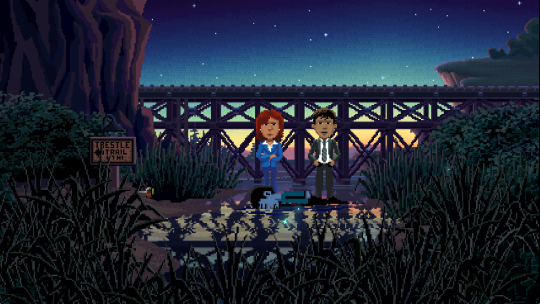
The democratization of game development - bringing with it both lowered price of entry for potential developers and new means of crowdsourcing the funding needed to build the games - has led to a resurgence of certain styles of game. Genres dismissed as risky by big publishers have seen something of a renaissance as indie developers emerge to fill the void.
This resurgence is most obvious when looking at platformers, especially Metroid-style sidescrollers. Just over a decade ago, Nintendo was the last holdout - now, you can’t navigate a digital storefront without tripping over a dozen of them. However, the indie wave has also benefited even more niche genres, like the adventure game. Fans of “point n’ clicks” have turned out in incredible numbers to back the genre, enabling both new entries - and incredibly - new takes from the developers that defined these games.
Earlier this year, Ron Gilbert and Gary Winnick - two of the geniuses behind LucasArts classics like Maniac Mansion and the Monkey Island series - released Thimbleweed Park, a love letter to their earlier titles. Today, Thimbleweed hits the Nintendo Switch, and I took a look.
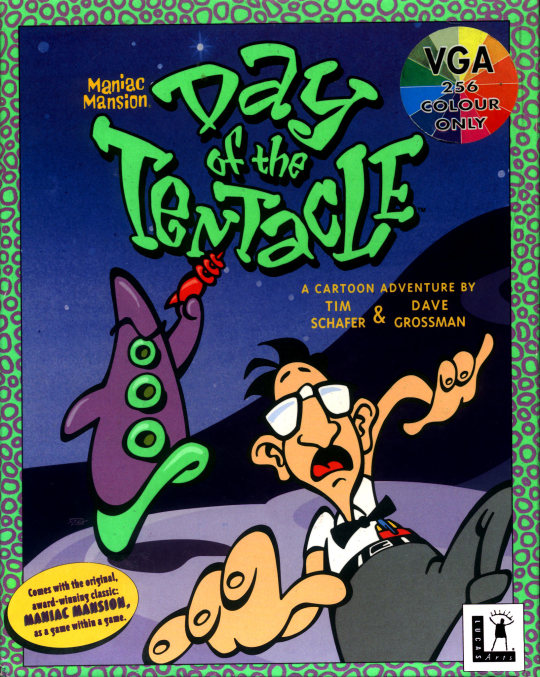
Like many overtly wordy 30-something nerds, I have a pretty extensive personal history with LucasArts and their adventure games. I came to gaming mostly via portables of all things. My first gaming experiences were on an Atari 2600 at my kindergarten's afterschool program, but the first device I actually owned was a Game Boy. The next step was, naturally, the SNES. I was hooked, and had to have more. However, money was fairly tight, so it was hard to justify a bunch of expensive cartridge purchases. However, we did have a Macintosh, and a seemingly endless number of garage sales tended to yield quite the selection of cheap computer games.
This was how I ended up with a copy of Day of the Tentacle. I basically based my entire purchasing decision on that awesome, shiny box. I had no idea what to expect. It just looked weird enough to appeal to my equally weird personality. I brought that thing home, popped it in, and started on an experience so memorable that it shaped my entire gaming life from that point on.
Day of the Tentacle was like nothing I had played before. Your interaction options in something like Super Mario World were pretty much limited to jump on, slam with turtle, or set on fire. Suddenly, in Day of the Tentacle, you had this detailed world to explore. You could pick up objects, inspect them, look at them, push them... on and on! All of this interaction was, of course, in service of solving complex puzzles in order to progress through the story. The puzzles were also mind-blowing. Twitch actions didn’t matter. You didn’t need precision timing. It was all about thinking, and reasoning, and making these insane deductive leaps. Sure, the logic was completely absurd, but I loved that.
Like I said, twisted weirdo.
Oh, and it’s worth talking about that story part. The writing in Day of the Tentacle was also far beyond anything I had seen in a game before. The descriptions and dialogue weren’t like those in a game, but more like a good book. It was funny, it was interesting. You played on for the writing, not for the thrill of defeating a boss.
My experience with Day of the Tentacle led to a life-long love affair with the genre - to Sam & Max, to The Sectret of Monkey Island, to Grim Fandango. Names like Ron Gilbert, and Tim Schafer, and Dave Grossman meant as much to me as Shigeru Miyamoto.
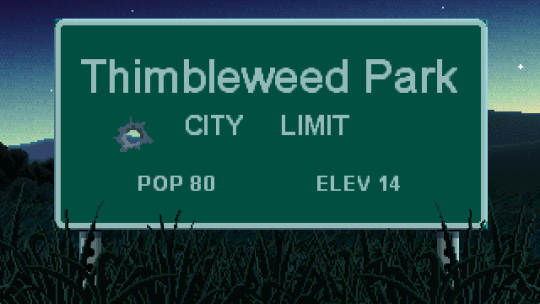
This leads us to Thimbleweed Park, which I somehow missed out on earlier this year. Fortunately, a release on Nintendo Switch gave me the perfect chance to rectify that situation. Thimbleweed Park reunites Ron Gilbert and Gary Winnick, two of the creators of Maniac Mansion. Gilbert and Winnick have absolutely designed the game as a throwback - and a love-letter - to their older work. This is obvious from the moment the game starts - presenting you with the familiar “verb” interface and 2D pixel artwork straight from the early 90′s (admittedly, a little cleaner and - obviously - higher resolution).
The story of Thimbleweed Park begins in October 1987, with a dead body pixelating under a bridge (in-jokes wait for no man) outside of a town sharing its name with the game. Two federal agents have been dispatched to investigate the murder, and not all is as it seems. Right off the bat, things are a little strange in Thimbleweed Park, and the mystery of the body quickly intertwines with the many threads of drama and intrigue engulfing the town - including the recent death of pillow-and-robot magnate Chuck, the plumbers in pigeon suits investigating signals, and a clown cursed to never remove his makeup.
Obviously, the murder investigation is going to be one of your lesser concerns.
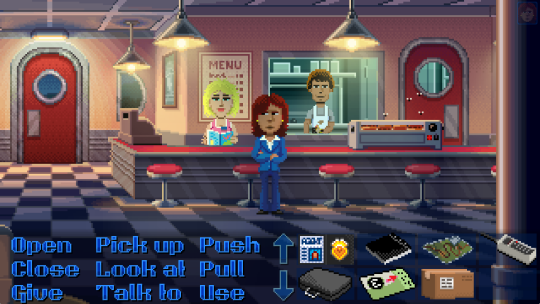
The story is equal parts classic LucasArts, X-Files, and Twin Peaks, and was seemingly designed to appeal to my tastes. Seriously. Neo-noir set in the Pacific Northwest, with off-kilter FBI agents? I don’t think they could have hit any closer to the mark without also including Picross-based minigames.
Also, the writing is great. Seriously. Gilbert has not lost his touch. People always remember LucasArts games for the jokes, and that type of mildly sarcastic, absurdist humor is absolutely present in Thimbleweed Park - especially in the references and winks to the player. I smiled it a few minutes in when they started talking about the body “pixelating”, and completely lost it when one of your characters discusses adventure game design with two girls in pigeon suits (MMucusFlem games were friendlier to the player, and did not have death or fail states).
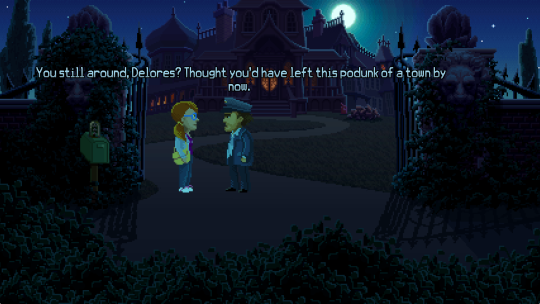
Of course, it isn’t all winking and fourth-wall breaking. As much as people remember of LucasArts games, they weren’t slapstick. They were funny, and generally a bit absurdist, but they were also genuinely well-written stories. The characters had memorable personalities, and their interactions - with other characters and the endless array of environmental objects - were interesting and fleshed out. This carries over to Thimbleweed Park. The kooks and weirdos you run into are people. They inhabit a town that feels lived-in. Thimbleweed Park looks entirely too much like so many small towns in this country - boarded up, suffering after the fall of their central industry. The entire affair is filtered through a thick helping of the surreal, but it’s also incredibly familiar to someone from a small town in West Virginia. When I started playing Dolores’ story, I felt for her. She doesn’t want to take over the family business. She wants to be a game developer - to work with the heroes behind her favorite adventure games. It’s hard not to feel sympathy for her, especially when you try to tell her uncle the truth, and another lie comes out instead of the dialogue option you selected as the player.
Thimbleweed Park is funny, but it’s also deceptively deep. The characters are memorable, and you keep playing just to find out what happens to them.
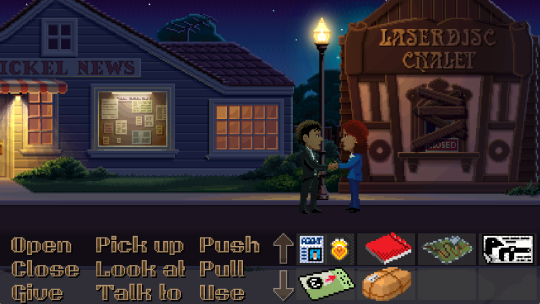
Of course, this is still a game, and you can’t talk about adventure games without taking about the puzzles - and more specifically, about game logic. Adventure game puzzles are famously abstruse. Need a moustache? Go find some honey and cat hair, and combine them. Need swiss cheese? Well, you have a gun and a block of cheddar. The leaps of logic could be fun to puzzle your way through, but a few of them would always make you tear your hair out.
Maybe this is why I’m bald.
Thimbleweed Park definitely lives up to this grand tradition. In one early segment, you need printer ink. Instead of popping over to the nearest Best Buy, you need to make your own. I don’t want to give away the whole process, but it involves firewood, gasoline, hot sauce, a glass, and a kitchen sink. I don’t think I was necessarily smarter as a kid, but I have no idea how I solved some of these puzzles before I had the internet at home.
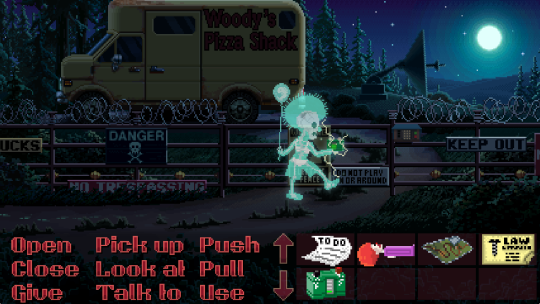
In Thimbleweed Park, you interact with objects and the world through a series of verbs, presented in the user interface. These verbs include “look at”, “pick up”, “open”, “close”, “push”, “pull”, “give”, “talk to”, and “use”. In many cases, multiple verbs will be applicable to a given object, but will have different results. In some cases, verbs require selecting multiple objects - for instance, you use the camera on the corpse. You have an inventory where you can store items you pick up. Not all items are useful, but you might want to collect everything not bolted down just in case.
If you do get stuck, you can pick up any in-game telephone and call a hint line for assistance. There are also two difficulty modes, in case you want to bypass some of the more abstruse puzzles and get on with the story.

The Switch version of Thimbleweed Park is the same game that is also available on PC, the other consoles, and - also recently released - mobile platforms. However, the nature of the Switch means that it can be played on both big screens and as a portable game. It also features both button-based and touchscreen controls. I’ve largely been playing in portable mode, and I’ve found that a mix of traditional and touch controls is the way to go. I tend to move and select dialogue using the buttons, but I use the touchscreen for choosing verbs and their targets. It works out pretty well.
It almost goes without saying that I have loved every moment of Thimbleweed Park. The writing is fantastic, from the story down to the setting and the character interactions. The puzzles are baffling, but enjoyable. I even love how the game looks. The pixel art has a distinct style to it (much like the classic LucasArts adventures), and every scene feels detailed and unique. If you’re a fan of the adventures that inspired Thimbleweed Park, or are intrigued by the genre, I cannot recommend this enough.
Official Website Nintendo eShop
A copy of the game was provided by the developer Terrible Toybox.
#video games#review#thimbleweed park#ron gilbert#terrible toybox#adventure game#point n click#greg4cr
0 notes